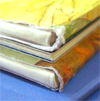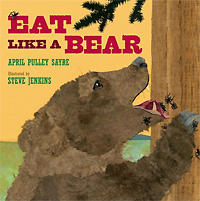|
|
|
|
|
|
|

| 최근 이 책을 구매하신 다른 회원의 책장 |
|
 |
|
|
|
[ 책 소개 ]
* 2014 An ALA Notable Children's Book
* Vermont Red Clover Children's Choice Award
* ALSC Notable Children's Book
* Bank Street Best Children's Book of the Year
* Green Earth Book Award Winner
2004년 Caldecott 수상작인 "What Do You Do with a Tail Like This?"의 Illustrator인 Steve Jenkins의 화려한 콜라쥬 그림이 돋보이는 자연과학 그림책입니다.
커다란 회색곰은 무엇을 먹고 살까요?
4월이 되자 긴 겨울잠에서 깨어난 회색곰은 오랜 굶주림으로 허기진 배를 채우기 위해 먹이를 찾아 동굴밖으로 나섭니다만, 이른 봄에는 연어도 없고, 베리도 없고, 덤불도 없네요. 결국 냇가에서 물로 배를 채웁니다. 하지만 눈을 뚫고 솟아나는 양치식물의 줄기는 훌륭한 요깃거리이고, 겨울에 얼어죽은 들소의 사체에서는 뼈에서 고기를 발라먹을 수 있습니다.
5월에는 방풍나물, 민들레, 골풀과 같은 식물들을 뜯어 먹고, 나무에 있는 개미집을 발톱으로 파헤친 후 새콤한 맛이 나는 개미들을 핥아 먹습니다.
6월에는 어린 동물새끼들을 잡아먹기 위해 쫓아 다니다가 짝을 만나게 되고, 차가운 계곡물 속에서 송어를 잡아 먹습니다.
이 책에서는 이런 식으로 회색곰이 7월, 8월, 9월, 10월까지 월별로 어떤 먹이들을 주로 먹는지를 사실적인 콜라쥬그림으로 보여주며, 아울러 겨울잠을 자기 전에 충분한 영양분을 섭취한 후, 동굴 속에서 겨울잠을 자면서 새로운 새끼들을 얻게 되는 회색곰의 모습도 함께 보여줍니다.
튼튼한 | 닫기x |  What is 하드커버? What is 하드커버?
양장본이라고도 불리우며, 표지가 단단한 판지로 만들어진 책입니다.
판지를 천이나 가죽으로 감싸기도 합니다. 책의 속지는 일반적으로 중성처리된 종이(Acid-free paper)를 사용해서 잘 변질이 되지 않기 때문에 오랫동안 보관하기에 적합합니다. 이 종류의 책은 더스트 재킷, 또는 더스트 커버로 불리는 표지덮개가 함께 있는 경우가 많습니다. 간혹 내부 속지가 콩기름 코팅이 된 경우 고약한 냄새가 나는 책도 있습니다.
|
[ 관련 동영상 보기 ]
 ▶
[ 서지 정보 ]
Hardcover: 32 pages
ISBN-10: 0805090398
ISBN-13: 978-0805090390
책 크기: 26.2 cm x 26.2 cm
[ 영문 서평 ]
Book Description
Can you eat like a bear?
A sleepy bear awakes in spring and goes to find food. But what is there to eat in April? In May? Follow along and eat like a bear throughout the year: fish from a stream, ants from a tree, and delicious huckleberries from a bush. Fill up your belly and prepare for the long winter ahead, when you'll snuggle into your warm den and snore like a bear once again.
School Library Journal
Posing the question, "Can you eat like a bear?" this book follows a brown bear as it forages for food throughout the year. Emerging from hibernation in April, the animal sets out on its quest. Each month provides a different delicacy: crispy roots and a ground squirrel in July, juicy huckleberries in September, a stash of pinecones in October. All serve to fatten up the omnivorous creature as it prepares once again for hibernation. The short text is set in a clear, large font and that, coupled with the big, full-color, cut- and torn-paper collage illustrations, makes it a natural for sharing with a group. The mammals themselves are rendered by using handmade Mexican bark paper. Its rough nature gives them greater impact and dimension on the pages. The extensive end notes provide details about the diet of the brown bear, or Ursus artos, its threatened status, and current scientific studies. This additional information increases the usefulness of the title, making it a viable classroom and research tool. That, along with the beautiful art, makes this a first choice for most libraries.
Booklist
A grizzly bear emerges from hibernation and starts to eat. Month by month she drinks, digs, scratches, hunts, fishes, and forages, fueling up in anticipation of another winter. Come November she returns to her den, ready for the next seasonal sleep, with a couple of cubs joining her. Sayre tells the simple tale in colorful free verse in careful patterns, rich with vocabulary: “Find . . . / . . . a squirrel’s pinecone stash. / Nibble, shred, crunch and smash.” Jenkins fixes the action in the Rocky Mountains with his trademark cut- and torn-paper collage. Using a variety of materials, including handmade Mexican bark paper for the bears, he achieves a remarkable variety of line and texture, as crisp leaves and flowers contrast with fuzzy fur. This contrast is mirrored in the juxtaposition of expressive narration and careful pictorial depiction. An appended assortment of notes offers substantive information about the bears, their habitats, behaviors, and study.
|
|
|
|
|
|
|
|
|
| |
|
|
Skulls!
New York Public Li..
7,400원 | | |
| |
| |
| |
|
|
Farm
Lift-the-Flap Tab,..
3,800원 | | |
| |
|
|
|
|
|